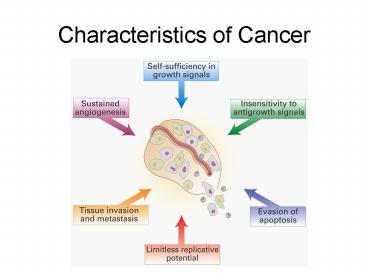Characteristics of Cancer - PowerPoint PPT Presentation
Title:
Characteristics of Cancer
Description:
Most epithelial cancers show a loss of E-cadherin function and this elimination plays a significant role in metastatic capability. II) ... – PowerPoint PPT presentation
Number of Views:105
Avg rating:3.0/5.0
Title: Characteristics of Cancer
1
Characteristics of Cancer
2
Initiation (irreversible)
Promotion (reversible)
More mutations Progression (irreversible)
malignant metastases
3
Different Steps of Carcinogenesis
Initiation Mutation in one or more cellular
genes controlling key regulatory pathways of the
cell (irreversible)must be a heritable DNA
alteration. Promotion selective growth
enhancement induced in the initiated cell and its
progeny by the continuous exposure to a promoting
agent. Progression results from continuing
evolution of unstable chromosomes further
mutations from genetic instability during
promotionresults in further degrees of
independence, invasiveness, metastasis, etc.
4
Initiation
- Initiation is the induction of a mutation in a
critical gene involved in the control of cell
proliferation. - As with mutational events, initiation requires
one or more rounds of cell division for the
fixation of the process. - The metabolism of initiating agents to
non-reactive forms and the high efficiency of DNA
repair of the tissue can alter the process of
initiation. - Initiation is irreversible although the
initiated cell may eventually die during the
development of the neoplasm.
5
Promotion
- Epigenetic eventchange in gene expression
without change in DNA. - Mitogenic (Not mutagenic) Stimulates
proliferation. Causes both mutated and normal
cells to proliferate. - Enhances the effect of the genotoxic initiating
agent by establishing clones of initiated cells. - Long delay possible between administration of
initiating agent and promoting agent. - Promotion is reversible.
6
(No Transcript)
7
(No Transcript)
8
(No Transcript)
9
(No Transcript)
10
(No Transcript)
11
Immortality
12
(No Transcript)
13
Go signals
14
(No Transcript)
15
(No Transcript)
16
(No Transcript)
17
(No Transcript)
18
(No Transcript)
19
Stop signals
20
(No Transcript)
21
(No Transcript)
22
(No Transcript)
23
Programmed Cell Death
24
(No Transcript)
25
(No Transcript)
26
Angiogenesis
27
Metastasis I) One of the most important proteins
is the cell-cell adhesion molecules (CAMs), whose
main role is to tether cells to surrounding
tissue. Among the CAMs, the most common protein
implicated in metastasis is E-cadherin, found in
all epithelial cells. In normal cells, E-cadherin
acts as a bridge between adjacent cells, enabling
cytoplasmic contact and sharing intracellular
signaling factors responsible for inhibiting
invasion and metastatic capability. Most
epithelial cancers show a loss of E-cadherin
function and this elimination plays a significant
role in metastatic capability. II) Another class
of proteins involved in tissue invasion are the
integrins, a widely distributed family of
heterodimeric transmembrane adhesion receptors,
which link cells to the extracellular matrix. In
addition to their role in angiogenesis, they also
play a central role in cell adhesion and
migration, control of cell differentiation,
proliferation and survival. Changes in integrin
expression are also evident in invasive and
metastatic cells. Successful colonization of new
sites (both local and distant) demands
adaptation, which is achieved by changing
integrin subunits displayed by the migrating
cells. For example, carcinoma cells facilitate
invasion by preferentially expressing integrin
subunits needed for binding to degraded stromal
components by extracellular proteases. III) Anothe
r strategy in successful colonization is
increasing expression of extracellular proteases
(such as MMPs ? Matrix MetalloProteinases) while
decreasing levels of protease inhibitors. Cells
in the stroma close to cancer cells secrete
active proteases, which facilitate invasion by
degrading components of the extracellular matrix.
This enables cancer cells to migrate across blood
vessel boundaries and through normal epithelial
cell layers.
28
These events often occur in a defined progression































